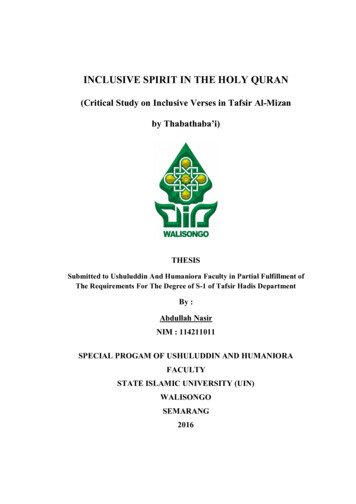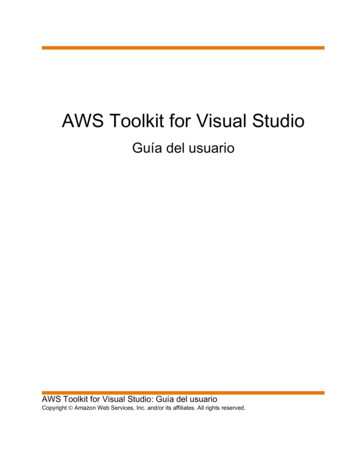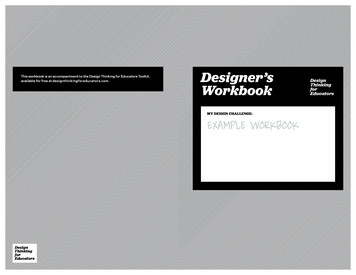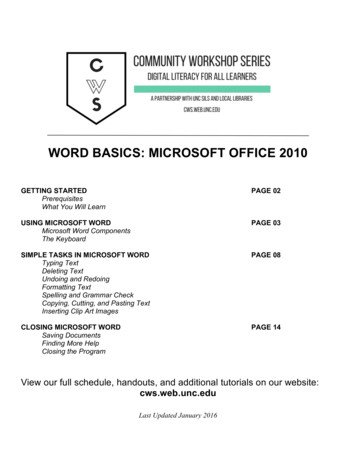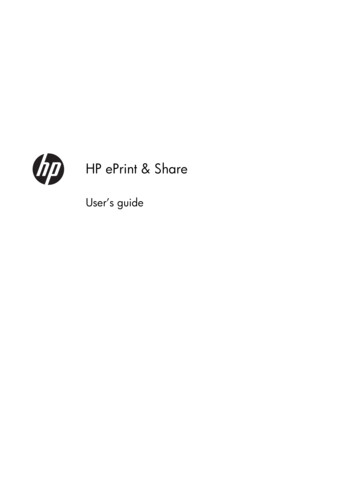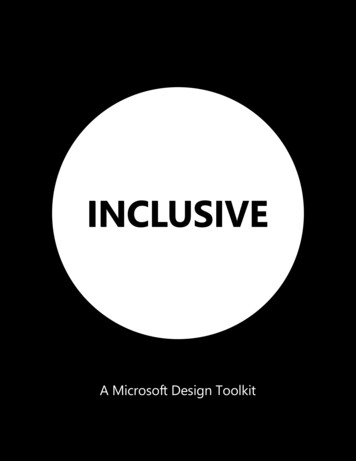
Transcription
A Microsoft Design ToolkitA Microsoft Design Toolkit
This toolkit is the start of a journey to shift ourmindset about inclusive practices. It offers simplestarting points for meaningful change.It’s for designers who want to make great productsfor the greatest number of people.We met many remarkable people while makingthis toolkit. We have a lot of work to do beforethese practices are our everyday routine. Untilthen, we’re inspired to share and improve inpartnership with each other. Microsoft 2015 Licensed under Creative Commons AttributionNonCommercial-NoDerivatives (CC BY-NC-ND)
ACKNOWLEDGEMENTSWe wish to thank the many people who contributed to this toolkit.By design, it’s a living collection of ideas and practices. It reflects awide community of people across Microsoft and beyond. We’d like togive a special thanks to a few key people. First, Jutta Treviranus, headof Inclusive Design at OCAD University, director and founder of theInclusive Design Research Centre and the Inclusive Design Institute.Next, Graham Pullin, Professor of Digital Interaction Design and Product Design at the University of Dundee and author of Design MeetsDisability. And finally, Allen Sayegh, Associate Professor in Practiceof Architectural Technology, Harvard Graduate School of Design andPrincipal at INVIVIA design firm. Thank you for your leadership in inclusive design and mindful design practices.
TABLE OF CONTENTSDEFINITIONIntroductionInclusive design has a strong heritage in accessibility. There are greatexamples of inclusive practices from architecture, physical product,and public spaces. Yet, digital technology presents new opportunitiesto expand this expertise in new ways.Part OneDisability is DesignedDisability is Universal & DynamicDisability Inspires Better SolutionsPart TwoDesigning for Human DiversityPart ThreeToolkit in PracticeIn this toolkit, we define inclusive design as a set of practices that canbe applied to any existing design process. Inclusive is how we design.It’s our tools and methods. In comparison, accessibility offer ways toimprove access to what is already designed.A curb cut is still a curb. The cut makes the curb more accessible.Inclusive design gives us ways to design for ever-changing humanmotivations and needs. And design systems that can adapt to fitthose diverse needs.
THE CASE FORINCLUSIVE DESIGN
ENGWHO WE DESIGN FOR If we use our own abilities and biases as a starting point, we end upwith products designed for people of a specific age, language ability,tech literacy, and physical ability. Plus those with specific access tomoney, time and a social network.29
WHO GETS EXCLUDEDWhen it comes to people, there’s no such thing as “normal”. Forexample, the interactions we design with technology depend heavilyon what we can see, hear, say, and touch. If we’re designing withourselves as a baseline, we can overlook people with circumstancesdifferent from ours.
WHY IT MATTERSDesigning for inclusivity not only opens up our products andexperiences to more people with a wider range of abilities. It alsoreflects how people really are. All humans are growing, changing,and adapting to the world around them every day. We want ourdesigns to reflect that diversity.So where do we start?
PART ONE
SEEING DISABILITYDIFFERENTLYWe can start with a fresh view of whatdisability really is. It was 1980 when theWorld Health Organization first publishedits formal definitions of disabilities. Theworld has changed since then, and so hasthe way the world looks at disabilities.It’s time to reexamine our approach.
1DISABILITY IS DESIGNEDThe first thing we learned is that defining disability as a healthcondition is a thing of the past.Today disability is a multi-faceted term. It covers situationalimpairments, activity limitations, and participation restrictions.All this means that disability is not a personal attribute.It reflects the complex way people interact with society.
1980Disability as a personal attribute“In the context of health experience, a disability is any restriction or lackof ability (resulting from an impairment) to perform an activity in themanner or within the range considered normal for a human being.”– World Health Organization
TODAYDisability as context dependent“Disability is not just a health problem. It is a complex phenomenon,reflecting the interaction between features of a person’s body andfeatures of the society in which he or she lives.”–World Health Organization
These points of interaction between a person and societyare where disability happens.As designers, it’s our responsibility to know how ourdesigns affect these interactions.We have an opportunity to create solutions with utilityand elegance for many people.
HEDHUMANINTERACTIONS
2DISABILITY IS UNIVERSAL & DYNAMICThe second thing we learned is that disability is universal anddynamic. This is a shift from thinking about disability as somethingthat only affects a small percentage of the population.In fact, most of us experience disabilities that are temporary andsituational on a daily basisFor example, mobile technolgies make disability highly relevant to ahuge number of people.
SOMETIMES DISABILITY IS TEMPORARYEven short-term injury and illness affect the way people interactwith the world around them. Looking into bright light can causebrief visual impairment. Being sick with a cough makes it hard tospeak. Wearing a cast can severely limit a person’s ability to lift aneveryday object.
SOMETIMES DISABILITY IS SITUATIONALAs people move through multiple environments, their abilities canalso change dramatically. In a loud crowd, they can’t hear well. In acar, they’re visually impaired. A new parent spends much of their daydoing tasks one-handed. What’s possible, safe, and appropriate isconstantly changing.
Because physical interactions with technologydepend heavily on what we see, hear, say, andtouch, the use of mobile technologies can makesituational disabilities highly relevant to manypeople today.
INCREASEDMOBILITY OFTECHNOLOGYINCREASEDMOMENTS OFDISABILITY
3DISABILITY INSPIRES BETTER SOLUTIONSThe third thing we learned is that seeing disability differently can inspire betterdesigns that benefit more people.When we understand that disability is a universal and dynamic way of interactingwith the world, it can become something else as well: a new source for creativity.Our impact can also expand, as our inclusive designs reach a greaternumber of people.
THE BEAUTY OF CONSTRAINTSDesigning for people with permanent disabilities can seem like asignificant constraint, but the resulting designs can actually benefit amuch larger number of people. For example, curb cuts in sidewalkswere first created to make it safer and easier for people in wheelchairsto cross the street. But curb cuts also help people with a wide rangeof circumstances, from kids riding bicycles, to parents pushingstrollers, to workers hauling heavy equipment.Similarly, high-contrast screen settings were initially made to benefitpeople with vision impairments. But today, many people benefit fromhigh-contrast settings when they use a device in bright sunlight.The same is true for remote controls, automatic door openers, voicecontrols, and much more. Designing with constraints in mind is simplydesigning well.wheelchairsstrollersbicycleseverybody benefits from curb cutsskateboards
DIFFERENT PEOPLE BENEFITBy designing for someone with a permanent disability, someonewith a situational disability can also benefit. For example, a devicedesigned for a person who has one arm could be used just aseffectively by a person with a temporary wrist injury or a newparent holding an infant.one armpermanentarm injurynew parentsituational
MORE PEOPLE BENEFITBeing mindful of the continuum from permanent to situationaldisabilities helps us rethink how our designs can scale to more peoplein new ways. In the United States, 26,000 people a year suffer fromloss of upper extremities. But when we include people with temporaryand situational disabilities, the number is greater than 20M.26K 13M 8Mone armarm injurypermanentnew parentsituationalTOTAL: 21M Source: United States Census Bureau, Limbs for Life Foundation, Amputee Coalition,MedicineHealth.com, CDC.gov, Disability Statistics Center at the UCSF
Touchone armarm injurynew parentblindcataractsdistracted driverdeafear infectionbartendernon-verballaryngitisheavy accentTHE PERSONA SPECTRUMWe use a persona spectrum to understand related limitations across aspectrum of permanent, temporary, and situational disabilities. It is aquick tool to help foster empathy and to show how a solution scalesto a broader audience.SeeHearSpeak
PERSONA NETWORKJust as no person exists in isolation, neither does the persona spectrum.It’s important to be aware of how people interact with each other. Thepersona network includes friends, family members or even strangers.
PART TWO
FROM SEEING TO MAKINGWe’ve come to see inclusive design as a set ofperspectives and practices that champion humandiversity. Take a moment to consider how youhave benefited from solutions that wereoriginally designed for someone with differentabilities. Take note of your own permanent,temporary, or situational disabilities that preventyou from interacting with society. Observe howpeople with different circumstances are excludedfrom participating in something you can dowithout barriers.Being inclusive starts with changingour perception.Now it’s time to put this mindset into action.It’s time to create new ways of making.Let’s get started.
DESIGNING FOR HUMAN DIVERSITYHumans have been at the center of design practices for a long time.As designers, we strive to make products that solve users’ needs,work well with the human body, and improve people’s lives. We focuson making products useful and usable. Human-led design builds onthis thinking.Human-led design presumes a diversity of peopleand their capabilities.It starts with three pillars that are universal to all people as theyinteract with the world: human beings have motivations that drivebehavior, they build relationships, and they have a keen sense ofwhat’s appropriate.In practice, human-led design leads to solutions that are universallyrelevant, but also adapt to individual limitations and situations.Human LedUser CenteredMindsetPracticeTools
VALIDATING OUR DESIGNSTraditional user-centered design has manytechniques to clarify human needs, frompersonas to scenarios to usability testing.But we also need tools that reintroducediversity back into our design process.We need ways to check, balance,and measure the inclusivity of our designs.
THE TOOLKITInclusive: A Microsoft Design Toolkit is made towork within an existing design process. It’s basedon three insights: Disability is designed Disability is universal and dynamic Disability inspires better solutionsWe can use this toolkit to evaluate our existingprocesses, develop new practices, and pilot thepractices we want to use.
BENEFITS OF INCLUSIVE DESIGNA solution that’s designed through inclusive practiceshas four distinct benefits:1. Increased access2. Reduced friction3. Improved emotional cues4. Be net-positive for people (value exchange)
PART THREE
TOOLKIT IN PRACTICEMost design processes are iterativeand heuristic. This toolkit aims tocomplement, not replace, the many existingtypes of design process. There are greathuman-centered design methods availablefrom multiple sources.Like a chef’s recipe, your own designprocess should be the primary direction foryour design. The elements of this toolkit canbe added, like ingredients, to improve theinclusivity of your process. How and whenyou integrate them is up to you.
We measure the success of Inclusive Design byevaluating if there is increased access, reduced friction,improved emotional cues, and a net-positive valueexchange for people. These are the beneficial resultsof designing inclusively.
GET ORIENTEDAT A GLANCESAMPLE DESIGN PROCESSAs we learn different perspectives, we need to apply them to thebigger picture that informs our designs. It can be helpful to reframeour thinking to see human limitations as possibilities.Here is a sample of how we put Inclusive Design into practice atMicrosoft. We design for a broad range of customers and thesemethods will evolve as we apply this toolkit across our products.FRAMEIDEATEITERATEOPTIMIZE
Familiarize yourself with the basics of inclusive design.Review accessibility criteria and create a list of criteria that relate to yourdesign. Interview stakeholders about customer, technical and businesscriteria.GET ORIENTEDResearch and try existing assistive tools that customers use to interactwith technology: Screen readers, motorized wheelchairs, communityresources, etc.GETTING IT RIGHTHave more questions than answersStart with HOW before figuring out WHAT you want to makeSet aside any existing solutions for this stage and Frame stageBe familiar with Inclusive Design terminology and anyaccessibility requirements
Conduct research methods. Interview and observe people along thisspectrum to understand how they interact with the world. Interviewpeople in the persona network and understand how they interact withpeople on the persona spectrum.Draw a persona spectrum. Identify who’s permanently excluded fromusing existing solutions, based on ability, age, geography, etc.Start with a universal human theme, without a specific solution in mind.Build an interaction map of existing solutions and identify points offriction that people encounter.Identify primary motivations and individual needs that connect thepeople on the persona spectrum.FRAMECapture and summarize what you’ve learned.GETTING IT RIGHTStep outside of what you think you knowGain insight from studies and people with a wide range of abilitiesand experiencesFocus by selecting a human unifier to addressIdentify principles or constraints you want to useOutline behaviors that the technology should imbueFrame the design challenge with a mismatch in technology in mindUnderstand the role of technology with the human interactions
Generate ideas related to your interviews and observations. Usebenefits of inclusive design to stretch your ideas: Increase access,reduce friction, improve emotional cues, be net-positive for people.If you need ideas, think about your observations from the personaspectrum and network. Identify specific mismatches betweenhuman-to-human interactions and human-to-technology interactions.Even act out the interactions to help clarify the gaps. What differenceswere most noticeable?Use human motivations to look for common themes. Cluster and groupsimilar ideas into cohesive concepts. Select the concepts that bestaddress the primary motivation for everyone on the persona spectrum.IDEATEGETTING IT RIGHTGenerate ideas and develop concepts rooted in human insightand a latent needDefine the human-to-human and human-to-technology mismatchPut people in the leadGenerate ideas inspired by human interactionCreate experiences with purposeful behaviorsClearly define at least one inclusive design benefit for a conceptEvaluate if concepts are a benefit to all
Identify what type of role your product plays in someone’s life.Is there a human metaphor for this role? Use this to research theresponsibilities and boundaries of the role.Identify the stages of relationship that people will have withyour product over time. Identify hero tasks and key interactions,big and small.Build a new interaction map and key scenarios to illustratethe design in context.Create a low fidelity prototype of your concept. Simulate thepersona spectrum and use the prototype.ITERATEConduct usability tests of prototype with people along thepersona spectrum.Check accessibility criteria and refine.GETTING IT RIGHTRefine the balance of creating “for one” and universalDefine a human analogy for your conceptCreate lo-fi prototypesDocument what parts of your accessibility checklist are addressedMap the interaction journey with considerations forthe stages of relationship, contextEvaluate across the full persona spectrum and iterate with different temporary and situational limitations
Build a high fidelity prototype of your concept. Simulate thepersona spectrum and use the prototype.Conduct usability tests of your prototype with people along thepersona spectrum.OPTIMIZEUse benefits of Inclusive Design to assess and measure improvements:increase access, reduce friction, improve emotional cues, benet-positive for people.Reflect on why your design matters and build a story for how it benefitseveryone along your persona spectrum.GETTING IT RIGHTClearly articulate the why for your solutionEvaluate using the benefits of inclusive design as a checklistBe brave and go back to iterate, if needed
As designers, it’s our responsibility tounderstand the power of the interactions wedesign for people. We design to embrace thethings that make us human. It’s what drives usto create a world that makes lives better.The result is technology that’s inclusive.For more information, contact inclusivedesign@microsoft.com
Plus those with specific access to money, time and a social network. 29 ENG. WHO GETS EXCLUDED. When it comes to people, there's no such thing as "normal". For example, the interactions we design with technology depend heavily . A Microsoft Design Toolkit is made to work within an existing design process. It's based on three insights:






